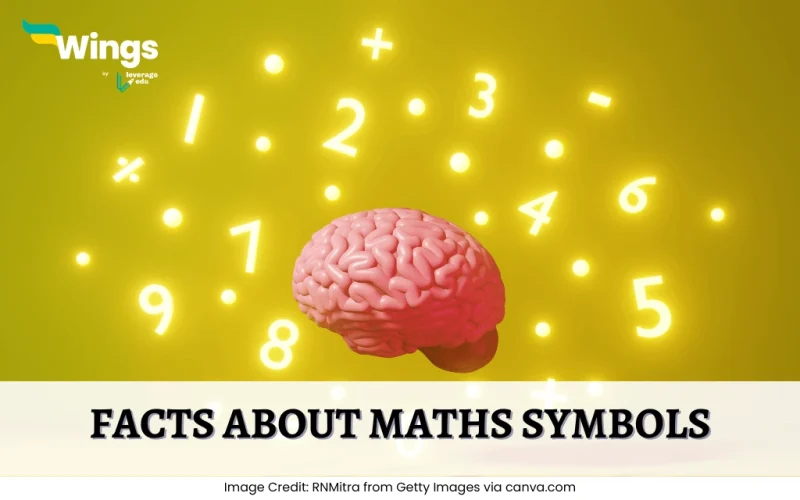Mathematics, a universal language, has its symbols and notations. Behind every equation and formula, you can find that symbols play an important role. These symbols have their own rich history, purpose and meaning. Starting from the plus sign (+) to the integral symbol (∫), mathematical symbols have become powerful and reliable tools that we can rely on. This blog covers the top 50 facts about maths symbols. Whether you are a math student or are simply curious about the hidden symbols, these facts are meant for you. Read and let us know which facts surprised you the most.
Table of Contents [show]
Who Found Maths First?
Mathematics was not started by one person or culture. Instead, the subject evolved as humans learned how to measure, count, and trade. The earliest evidence of using mathematics (30,000 BC) can be found in markings on animal bones. Thereafter, civilizations like the Egyptians, the Babylonians, and the Greeks made significant contributions to the development of mathematics. Therefore, we cannot study the facts about maths symbols just by knowing about a single person or culture.
Who Invented the Maths Symbols?
Mathematical symbols are introduced over time by mathematicians across the Middle East and Europe. Therefore, as we said before, facts about maths symbols are not one. There are many. Some of the key highlights are-
- Robert Recorde invented the equals sign (=) in 1557 because he believed no two things can be more equal than parallel lines.
- Johannes Widmann (1948) first introduced the plus (+) and minus (−) signs in his books.
- Johann Rahn (1656) was the first person to use the division sign (÷), or obelus, for division purposes.
- Christoff Rudolff introduced the square root symbol (√) in 1525.
- John Wallis introduced the infinity symbol (∞) in 1655.
- William Jones was the first person to use the pi symbol (π) in 1706. However, the symbol was made popular by Leonhard Euler.
- Thomas Harriot was the person who came up with the less than (<), and the greater than (>) signs in 1631.
- Christian Kramp introduced the factorial symbol (!) in 1808.
- During the 1600s, Gottfried Wilhelm Leibniz introduced the integral symbol (∫).
- Leonhard Euler introduced the sigma (∑) sign for summation.
Quick Reference: Essential Math Symbols
Here is a quick reference table to explain the facts about maths symbols. The table will help you to understand the math symbols in a better way.
| Symbol | Name | Description | Example/Usage |
| ∑ | Summation | Denotes the sum of a series of numbers | ∑<sub>i=1</sub><sup>n</sup> a<sub>i</sub> |
| π | Pi | Represents the ratio of a circle’s circumference to its diameter | ≈ 3.14159 |
| + | Plus | Represents the addition operation | 3 + 4 = 7 |
| ÷ | Division | Denotes division between numbers | 10 ÷ 2 = 5 |
| ≠ | Not Equal | Indicates that two values are not equal | 5 ≠ 3 |
| – | Minus | Represents the subtraction operation | 10 – 2 = 8 |
| ∞ | Infinity | Represents an unbounded or endless quantity | Limit as x → ∞ |
| × | Multiplication | Denotes the multiplication operation | 4 × 3 = 12 |
| = | Equals | Indicates equality between two expressions | 2 + 2 = 4 |
| ∫ | Integral | Used in calculus to represent integration | ∫ f(x) dx |
Logical & Set Theory Symbols
Here are some additional facts about math symbols. The facts presented below are of logical symbols and set theory symbols.
- In the 19th century, Gottlob Frege standardized the logical symbols like ∨ (or),∧ (and), and (not).
- William Oughtred is the person who introduced the not equal symbol (≠). He is also the person who invented the slide rule.
- Alfred George Greenhill 1892 introduced the equal symbol l (≈) in 1892.
- Giuseppe Peano is the person who introduced the element-of symbol (∈) in 1889.
- Since the 18th century, the triple bar symbol (≡) has come to be known as identical to” or “congruent to,
- Starting from the 17th century, the symbol (∴) was used. It was used for shorthand.
- The Bourbaki group popularized the empty set symbol (∅) in the 1930s. It was taken from a Danish letter Ø.
- The theory symbols like the ∩ (intersection), and ∪ the (union) started to be used only in the 19th century.
- The turnstile symbol (⊢) represents the syntactic entailment in logic.
- Georg Cantor introduced the aleph symbol (ℵ). It represents the cardinality of infinite sets.
Also Read: 10 Facts About Ramanujan: The Greatest Mathematician
Algebra & Number Theory Notations
These are some facts about maths symbol algebra and number theory notations:
- The absolute value represented by the modulus symbol (|a|). The symbol represents a distance on the number line.
- Leibniz introduced the dot (·) symbol for multiplication in 1698.
- Adrien-Marie Legendre introduced the partial derivative symbol (∂) in 1786.
- The nabla symbol (∇) is taken from the Greek harp shape, and it represents the gradient or del operator.
- It was René Descartes who systemised the exponential notation (e.g., 10⁶).
Geometry & Trigonometry Symbols
These are some facts about maths symbols about Geometry & Trigonometry.
- You can trace back the angle symbol (∠) to Euclidean geometry in 300 BC.
- The vector arrow (→v) signifies magnitude and direction
- The vectors are represented by arrows. They convey both magnitude and direction.
Fun & Surprising Facts About Math Language
Some fun and surprising facts about math symbols that you must know.
- The word hundred is taken from the Old Norse (German) term hundredth. This means 120.
- Starting from 0 to 1000, the only number that consists of the letter ‘a is one thousand.”
- The only number that can be spelled with its letters in alphabetical order is the number forty.
- The only number with letters in a descending alphabetical order is the number 1.
- The Four is the number that has the same number of letters just like the number itself.
- Every odd number has the letter (e) in it.
- The Shakespearean play- The Taming of the Shrew consists of the word mathematics. It is the only play of Shakespeare that mentions the word
- The pie chart is called a “Camembert” in France.
- Americans call ‘math’ instead of ‘maths’ because mathematics is used as a singular noun
Also read- 23+ Interesting Facts About Mathematics in Daily Life
Pattern Play & Number Trivia
These are some additional facts about the maths symbol you must know about-
- “Eleven plus two” is an anagram of “twelve plus one”. This means both equal to number 13.
- Moreover, both of the above phrases consist of only 13 letters.
- There is a 50% chance that 2 people will have the same birthday in a room of 23 people. This is called the birthday paradox.
- Zero is a number that is not included in the Roman numerals.
- -40 °C is equal to -40°F.
- A jiffy is treated as a real unit of time. It is equal to 1/100th of a second.
- When you properly shuffle a deck of cards, you will get an order that has never occurred before in history
- The n! (factorial) grows so fast that 100. It has around 158 digits in it.
Timelines & Historical Contributions
These are some facts about maths symbol and their history.
- Till the 16th century, most mathematical symbols were not invented. Before the 16th century, equations had to be written in words.
- The Roman numeral for 1,000 was inspired by the infinity (∞) symbol.
- The equal sign was selected because two parallel lines mean the same thing.
- The integral symbol (∫) is taken from the Latin word (summa) meaning sum.
- The Greek letter sigma (∑) was started to be used as a universal symbol for summation because of Euler.
FAQs
Different maths symbols were introduced by different people. Mathematics evolved over time. For example, Robert Recorde invented the equals sign, René Descartes introduced superscript notation for exponents, and the iccolò Tartaglia introduced parentheses.
Mathematics developed over time with contributions from different cultures. Therefore, it is not possible to pinpoint one single person as the inventor. However, the earliest evidence of mathematics can be found in the ancient text of the Sumerians in Mesopotamia, around 3000 BC.
The full form of maths is mathematics. Maths is an abbreviation used for mathematics. Moreover, it is important to note that in American English we use ‘Math’ as the abbreviation, and not ‘Maths’.
The number Zero was discovered by the Indian mathematician Brahmagupta. He discovered the number during the 7th century AD. However, the concept of Zero has existed earlier.
The word maths is taken from the Ancient Greek word máthēma (μάθημα). This word means ‘something learned, knowledge, mathematics’,. The word entered the English dictionary during the Late Middle English period through Latin and French.
Related Reads
The word maths is taken from the Ancient Greek word máthēma (μάθημα). This word means ‘something learned, knowledge, mathematics’,. The word entered the English dictionary during the Late Middle English period through Latin and French.
These were the facts about Maths symbol. If you find it fascinating and wish to read more such interesting facts, then stay tuned to the General Knowledge page of Leverage Edu.
 One app for all your study abroad needs
One app for all your study abroad needs















 45,000+ students trusted us with their dreams. Take the first step today!
45,000+ students trusted us with their dreams. Take the first step today!
